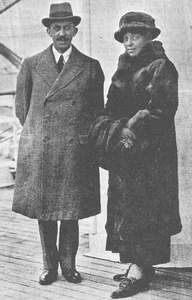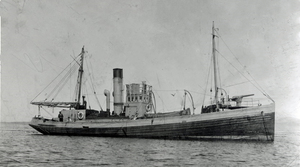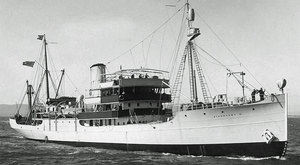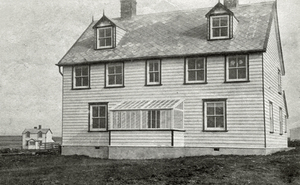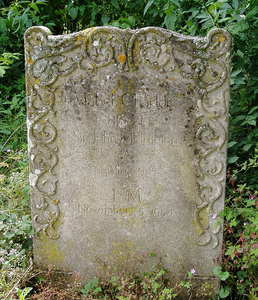MIDDLETON, Sir JOHN
1870 - 1954 from Scotland
governor, was born on 12 July 1870, the son of Dr James Middleton of Stow, Midlothian. He was educated at Sedbergh and Edinburgh University. In 1901 Middleton entered the Colonial Service as an assistant district commissioner in Southern Nigeria.
When the Colony of Lagos and its protected territory were amalgamated with the Protectorate of Southern Nigeria in 1906, he became chief assistant colonial secretary. In 1907 he was appointed assistant colonial secretary in Mauritius. In 1913 Middleton became colonial secretary of Mauritius.
In 1920 he became governor of the Falkland Islands. He arrived in Stanley with his wife on Christmas Day of that year, landing from RMS Orita to a salute of guns from HMS Weymouth. After inspecting a guard of honour from the Defence Force, he took the oaths of office in the Council Chamber and then, according to an account in the Falkland Islands Magazine: 'made a short speech in the course of which he mentioned that it was his desire to administer the government in such a way as to promote the best interests of the Colony and its inhabitants'.
Middleton's early years in office were notable for the appointments of the first government geologist (HA BAKER) and forestry officer (REID), together with efforts to re-establish a fur seal industry. These initiatives were given impetus by a serious slump in wool prices in 1921, which left many farms in financial difficulties and led to much reflection on the economic future of the Islands.
Middleton made an historic speech to LegCo on 23 July 1924 on the state of the sheep farming industry. His speech revealed both his extensive knowledge and his deep concern for those working within the industry: 'I have made it my duty to collect such information as I could'. It outlined the problems of the deteriorating quality of the grassland, and the subsequent decline in the aggregate number of sheep carried. A number of the leading farmers in the Colony shared Middleton's assessment of the state of the main industry of the Islands in the 1920s. As a result of his speech, the Falkland Islands' Government agreed to fund the work of Hugh MUNRO, a senior stock inspector from the Department of Agriculture in New Zealand, from the Land Sales Fund. Munro's Report, published at the end of 1924, was the first systematic examination of the condition of the natural resources of the Falklands, and how they might be more effectively managed and exploited. To accompany the Munro Report, Middleton wrote a long and comprehensive memorandum on the sheep farming industry of the Islands (Middleton, J; Memorandum on the Sheep Farming Industry in the Falkland Islands; London 1924). This recalled that thirty years before Munro's investigations in 1895 another much shorter Report had been written by a New Zealand Stock Inspector John Mowat which also expressed considerable concern about the deterioration of the pasturage of the Falkland Islands.
Middleton's speech and the report by Hugh Munro were to result in the building of an experimental farm at Green Patch (near the headwaters of Berkeley Sound). Middleton's philosophy was based on the adage that 'seeing was believing' and thus the only way to improve the situation, and to educate farmers into accepting new farming methods, was a working example of good practice.
Middleton made no secret of his admiration for Munro's work; the Colonial Secretary wrote to Munro (in November 1924) thus:
I am desired to convey to you an expression of the thanks of the Government for the services which you have rendered to the country in presenting so able an exposition of the damage to the pastures which has resulted from the system of farming in the past, of the defective methods of farm management and of the remedial measures which should be adopted. I am to convey to you the Governor's particular appreciation of the fact that you have, in the course of your investigations and discussions with the farmers, been successful in securing and retaining the goodwill and respect of those whose methods and farming practices you have found it necessary to criticise.
Middleton was also concerned with the economic disposal of surplus sheep, and he considered that the requirement for the establishment of a refrigeration factory to be most urgent. This was the first time that this suggestion had been made, and the idea was raised again by Governor HENNIKER HEATON in 1939. Governor Sir Miles CLIFFORD championed the idea after World War II, and the Ajax Bay freezer complex was eventually built on San Carlos Water between 1949 and 1953. Another major concern of Middleton was the need for the various elements of the farming industry to cooperate in the marketing of its products.
Middleton's initiatives, and practical reforms to enable a more sustainable agricultural system on the Falkland Islands, were regrettably soon destroyed by the activities of his successor as governor - Arnold HODSON - who ensured that the experimental farm was closed down within a few months of his arrival in the Falkland Islands.
During the early 1920s Middleton became very concerned about the diminishing numbers of Fur Seals in the Islands, and he drafted The Seal Fishery (Consolidation) Ordinance 1921 to protect the existing stocks; this legislation was swiftly enacted.On his instructions the government naturalist (JE HAMILTON) visited Elephant Jason Island, Bird Island and Volunteer Rocks between October 1921 and March 1923, and his report showed that although the exact number of Fur Seals could not be stated with complete accuracy, nevertheless the numbers were fewer than had been indicated in earlier reports. The government naturalist recommended that a 3-inch naval gun be placed on Elephant Jason Island to deter poachers. By March 1922 a guardhouse was built on Elephant Jason Island. Cattle were landed to provide milk and meat for the three personnel, and a 12-pounder gun was placed in position. Seal fishery officers were appointed in 1922 and armed officers were placed at major rookeries during the breeding season. Fur sealing was prohibited. HMCS Afterglow was purchased (at a cost of £8,800) to assist with protection of the rookeries. Middleton's actions were criticised within the Colony because of fears that the cost of this protection could not be met from the revenues that accrued to the Government from the licensing of the sealing industry. The effectiveness of Middleton's work to conserve the Fur Seal stocks was soon dissipated by his successor, Arnold Hodson, who ensured that the Afterglow was sold off and the guard on Jason Island withdrawn.
Middleton was also concerned with the potential threat to the stocks of whales after technology had improved sufficiently to allow the change from shore-based whaling to pelagic* whaling. He considered that there was a possibility of the extinction of whales in the Antarctic, and wrote in September 1926 to the Colonial Office that 'the control and suppression of pelagic whaling was impossible'. Middleton faced enormous practical difficulties of supervising the Southern Ocean: 'the absence of a patrol boat meant that the Governor has no means of controlling the floating factories' Middleton fully understood that an added complication to the problems of regulation and control of whaling was caused by the fact that while early pelagic whaling was within Islands Dependencies waters, and thus under government control, the later stages of pelagic whaling were well outside the Governor's bailiwick, and therefore beyond government control. Middleton had shown a deep appreciation of the true nature of the situation concerning the whaling industry and he enthusiastically supported the research work of the Discovery Expeditions.
In 1927 Middleton became the governor of the Gambia, and one year later governor of Newfoundland. The later period of his governorship of Newfoundland was seriously marred when he became embroiled in the political scandals that engulfed the administration of Prime Minister Sir Richard Squires. Squires was accused of falsifying minutes of the Executive Council and in April 1932 10,000 people marched to the House of Assembly to protest at the activities of the government, and there was serious rioting. Middleton investigated the matter and he controversially declared that he found no evidence to support the allegation that the minutes had been tampered with. Richard Squires resigned in June 1932, and although Middleton was held in high personal regard, he felt honour bound to resign as governor.
He was awarded the CMG in 1916. He was knighted (KBE) in 1924 and in 1931 he was made a KCMG.
Middleton married Mabel Granville, the widow of RK Granville and the daughter of Lieutenant-Colonel Notley, of Wiltshire. There were no children of the marriage.
On leaving Newfoundland, Middleton retired to Laycock in Wiltshire; his wife died in 1947, and he died on 5 November 1954.
Middleton was a far-sighted and imaginative man of vision who had planned for the future of the Colony. A later governor, Henniker-Heaton, who served under Middleton in the Falkland Islands as colonial secretary, wrote to The Times on 10 November 1954:
A special tribute should be paid to the memory of the late Sir John Middleton. He was as nearly the perfect Colonial Civil servant as any individual could be... As Governor of the Falkland Islands and its dependencies his work for improvements in the sheep farms and in the control of the whaling industry was of great value; he also re-established the fur seal in the colony.
External links
See: Falkland islands Journal - complete listing 1967-2020
See: Memorandum on the Sheep Farming Industry in the Falkland Islands - 1924.pdf
References
Stephen Palmer: 'Governor John Middleton (1870-1954)' Falkland Islands Journal 2009; pp 87-117
Sir Herbert Henniker Heaton; Governor of the Falkland Islands 1934-1941; Obituary for Sir John Middleton; The Times 10 November 1954
Falkland Islands Magazine and Church Paper; August 1924
Comments
Revisions
May 2019 additional photograph added
June 2019 Three additional photographs added
September 2019 Reference added; three external links added
December 2019 One additional photograph added
February 2020 One additional photograph added; one external link added

